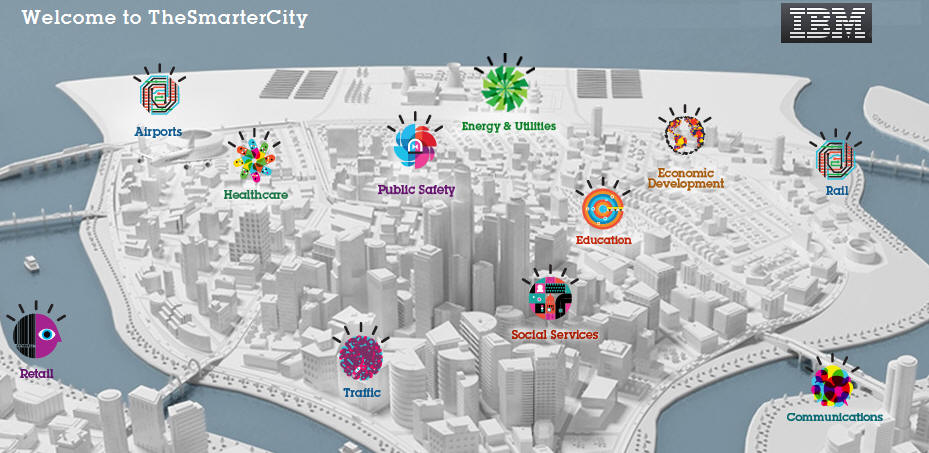
BIG
BLUE
Corporatism
Fusion Centers - Part 5


IBM's Vision of the Smart City (for Prisoners)
A major step in the march to fascism begins in 1988 with legislation sponsored by then Senator Al Gore to fund the building of a high speed, nationwide "data superhighway" that would allow corporations and researchers at the universities and national laboratories to collaborate in research, product and systems development. While it might have sounded like a good idea at the time, it was the beginning of the socialization of business costs and the privatization of profits from those public expenditures. It also set the stage for the corporate takeover of government.
New York Times, December 28, 1988, Sharing the Supercomputers
"Officials at the National Science Foundation envision computerized ''collabatories'' in which scientists using computer work stations could directly view and control the output of complex machines, such as particle accelerators, wind tunnels, telescopes and nuclear reactors, even though they were thousands of miles from the actual apparatus."
''The infrastructure we will need in the 21st century goes beyond traditional public works projects,'' Senator Gore said. ''I envision a national computer network linking academic researchers and industry, using the nation's vast data banks as the raw material for increasing industrial productivity and creating new products.''
''It's possible that if we simply let a completely self-motivated marketplace develop our data communications infrastructure for the future it will be either inferior to what is being developed in Japan or Europe or owned by companies in Japan and Europe,'' said Russell Neuman, a political
scientist at the Massachusetts Institute of Technology Media Lab.
In 2011, IBM had their centennial celebration. On their website, there is a section devoted to their accomplishments as a corporation. They list the top 100 of their innovations in the world of computing and business machines. One of those is titled Rise of the Internet:
In 1985, the National Science Foundation (NSF) launched an initiative to build a state-of-the-art national backbone network, an inter-net, that would be based on transmission control protocol/Internet protocol (TCP/IP) and would link supercomputer centers and regional academic networks....A number of universities and companies participated in its development, including IBM. Recognizing that much of this new network would have to be invented and lashed together, the NSF solicited proposals and awarded the project to IBM, MCI, the State of Michigan (home to a large community of computer scientists and keen to link up existing telecommunications networks within the state) and a consortium of universities in November 1987.In 1987, IBM, working with the U.S. National Science Foundation and our partners at MCI and Merit designed a new high-speed National Science Foundation Network (NSFNET) to connect US universities and 6 US-based supercomputer centers. The NSFNET greatly increased the capacity of the Internet (increasing the bandwidth of backbone links from 56 Kilobits/sec to 1.5 Megabits/sec to 45 Megabits/sec) and greatly increased the reliability and reach of the Internet—reaching more than 50 million users in 93 countries when management of the Internet infrastructure was transferred to the telecom carriers and commercial Internet Service Providers in 1995.
In the New York Times article above, there was a lot of
hand wringing about maintaining our "technological edge" over Europe and Japan.
In 1986, the European Union had initiated a pan-European roads automation
project:
PROMETHEUS was started in 1986 and was initiated as part of the EUREKA program, a pan-European initiative aimed at improving the competitive strength of Europe by stimulating development in such areas as information technology, telecommunications, robotics, and transport technology. The project is led by 18 European automobile companies, state authorities, and over 40 research institutions. The budget for the project is over $800 million and the project is scheduled to last 7 years.
PROMETHEUS is a pre-competitive research project, with the output being a common technological platform to be used by the participating companies once the product development phase begins. The overall goals of PROMETHEUS fall into four categories:
Improved driver information - providing the driver with information from new sources of technology that were not previously available. Currently, the lack of information or the inability to assess a hazard is often the primary cause of accidents.
Active driver support - when the driver fails in some way at the driving task, the system may aid the driver in an informative way or by active intervention.
Cooperative driving - establishing a network of communication between vehicles in order to provide drivers with relevant information for areas en route to their destination.
Traffic and fleet management - systems for the efficient use of the road network, ranging from highway flow control to fleet operations.
Not coincidently, a federally mandated, regional transportation study named Mobility 2000 was completed in 1986. After a series of conferences over a two year period, a group calling themselves Mobility 2000 was formed to develop a national program of automated highway technology ala Prometheus:
"Founded in 1988, Mobility 2000 was an informal assembly of industry, university, and government representatives created to promote the use of advanced technologies to improve highway safety and efficiency. The initiative was formalized in 1991, when the Intermodal Surface Transportation Efficiency Act (ISTEA) was enacted, and the national Intelligent Vehicle Highway System (IVHS) program was established. A growing sense soon developed in the IVHS community, especially in the public transit arena, that “intelligent vehicle highway systems” did not embrace all the transportation modes addressed in the national IVHS program. In 1994, the national IVHS program was renamed the Intelligent Transportation System (ITS), to clarify the multi-modal intent. Corridor Master Plan, Colorado Department of Transportation, April 1996, Page I-5
The Intelligent Vehicle Highway System was just the beginning of 'BIG SYSTEMS' automation of the infrastructure leading directly to the "reinvention of government" under the direction of BIG SYSTEMS designers. When Clinton and Gore came into office, it was with the intention of continuing the Big Systems developments that were initiated under the George H. W. Bush Administration.
Reinvention of America
From BIG HIGHWAY systems to BIG INFRASTRUCTURE under the cover of national security, we've had a mob takeover of our country.
They drove IBM's stock down at which point John Akers resigned and Lou Gerstner took over as CEO. After nine years at IBM, Lou Gerstner became the Chairman and CEO of the Carlyle Group.
 New Jersey Prosecutor (ha! would you let this man protect YOUR infrastructure?) |
Keyman at American Express and McKinsey
& Company, MBA from Harvard |

Sam Palmisano and
Obamanation
|
|
|
|
The word archipelago compares the
system of labor camps spread across the Soviet Union with a
vast "chain of islands", known only to those who were fated
to visit them.
Wikipedia
|
The 1991 Intermodal Surface Transportation Efficiency Act (highway legislation) signed by George H.W. Bush defined the zones creating the "chain of islands". There were many pieces of legislation to integrate the education system into "workforce development" so they can't be listed here except for one that GHWB signed, the Job Training 2000 Initiative signed in 1992. |

Vicky Davis
May 24, 2013